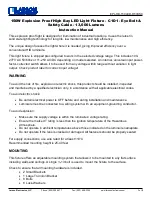
3°)
Rescue lift (with rescue pole):
Using
Lift Res-Q
, people can be rescued from a lower to a higher position
with a rescue pole.(e.g. FA 70 020 00).
Example:
While working on a tubular structure, a worker slips and falls,
secured by his fall arrest system. (cf.
Fig. 1
)
3°)
Winda ratownicza (z tyczką ratowniczą):
Za pomocą podnośnika Res
-
Q można ratować ludzi z niższej pozycji na wyższą
za pomocą tyczki ratunkowej (np. FA 70 020 00).
Przyk
ł
ad
: Podczas pracy na konstrukcji rurowej pracownik poślizgnął się i
upadł, zabezpieczony przez swój system powstrzymywania spadania.
(cf.
Fig.
1
)
The rescuer immediately fixes the karabiner of
Lift Res-Q
on the tubular structure using an
anchorage lanyard. Then he pulls the short
rope end until the karabiner on the rope end
reaches the victim.
Ratownik natychmiast mocuje karabinek Lift Res-
Q do kons
trukcji rurowej za pomocą lonży
kotwiczącej. Następnie ciągnie za krótki koniec
liny, aż karabinek na końcu liny dotrze do
poszkodowanego.
2
The rescuer attaches the karabiner of the
shorter rope end to the rescue pole. Then he
hooks the karabiner in the eyelet of the
victim’s overall (using the rescue pole). Then
he tightens the rope end.
Ratownik wpina karabinek krótszego końca liny
do tyczki ratowniczej. Następnie zaczepia
karabinek
w
oczku
kombinezonu
poszkodowanego (używając
tyczki ratowniczej).
Następnie napina koniec liny.
3
He attaches a battery screwdriver to the Lift Res-Q
and carefully lifts the victim up.
He could also manually lift him up using the hand
wheel, in which case he would guide the rope
through the rope clamp to ensure a safe rescue. In
this case, he can clamp the rope in the rope clamp
and pull the rope after a couple of turns. He can
thus secure the height.
Podłącza on śrubokręt akumulatorowy do urządzenia
Lift Res-
Q i ostrożnie podnosi
ofiarę do góry.
Może również podnieść poszkodowanego ręcznie,
używając kółka ręcznego, w którym to przypadku
przeprowadza linę przez zacisk linowy, aby zapewnić
bezpieczną akcję ratunkową. W tym przypadku może
zacisnąć linę w zacisku linowym i pociągnąć ją po kilku
obrotach. W ten sposób można zabezpieczyć
wysokość.
Always use
the slowest gear
of the battery screwdriver (max. 350 rpm); suggested
minimum torque 20 Nm.
Należy zawsze używać najwolniejszego biegu wkrętarki akumulatorowej (maks.
350 obr./min.); sugerowany minimalny moment obrotowy 20 Nm.
OPERATING TESTS:
Before each use check if the rope runs smoothly. Pull both
rope ends slowly one after the other. If you feel slight
resistance, the product works. Check the fly wheel brakes. Pull both rope
ends quickly one after the other. If you
hear a „click“ and the rope resists
slightly when you pull it, the brakes are OK. Then check the operation of
the device.
Warning!
Beforehand, take the necessary precautions in order
to eliminate any risk of a fall by being auto-belayed or by auto-belaying
the person to be descended (use of an independent fall-arrest system).
TESTY DZIAŁANIA
:
Przed
każdym użyciem należy sprawdzić, czy lina porusza się płynnie.
Pociągnij powoli za oba końce liny, jeden po drugim. Jeżeli wyczuwalny jest
lekki opór, produkt działa. Sprawdzić działanie hamulców koła zamachowego.
Pociągnąć szybko oba końce liny jeden po drugim. Jeśli słychać "kliknięcie", a
lina stawia lekki opór podczas ciągnięcia, hamulce są w porządku. Następnie
należy sprawdzić działanie urządzenia. Ostrzeżenie! Przed przystąpieniem do
pracy należy podjąć niezbędne środki ostrożności w celu wyeli
minowania
ryzyka upadku w wyniku automatycznej asekuracji lub automatycznej
asekuracji osoby, która ma być zjeżdżana (zastosowanie niezależnego systemu
asekuracji).
This device was tested for a descending energy greater than 7.5 x 106 J:
Calculation formula W=m x g x h x n
W=energy (J); m = mass = 225 kg; G = acceleration =
9.81ms-2; h = height= 300m; n = descent number = 11
Warning !
During use, you absolutely must make sure
to account for this total energy.
Urz
ą
dzenie to by
ł
o testowane dla energii zej
ś
cia wi
ę
kszej ni
ż
7,5 x 106 J:
Wz
ó
r obliczeniowy W=m x g x h x n
W=energia (J); m = masa = 225 kg; G = przyspieszenie = 9,81ms-2; h =
wysoko
ść
= 300m; n = liczba opadania = 11
Ostrze
ż
enie !
Podczas u
ż
ytkowania nale
ż
y bezwzgl
ę
dnie pami
ę
ta
ć
o
uwzgl
ę
dnieniu tej ca
ł
kowitej energii.
1





































